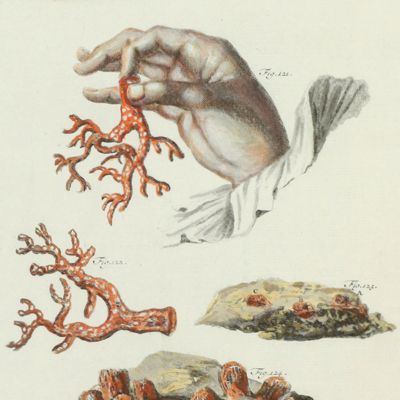Marsigli, L. F. Comte de (Marsilli, L. Graave van)
Natuurkundige Beschryving der Zeeën.
's Gravenhage, De Compagnie, 1786. Folio (41.6 x 26.0 cm). Half-title, a nice hand-coloured engraved allegorical frontispiece, title page with woodcut vignette. [ii], xxvi, 216 pp.; seven mostly folded engravings, five hand-coloured engraved maps and profiles, and 40 beautifully hand-coloured engraved plates (for a total of 52 plates and maps), woodcut endpieces and capitals. Contemporary half calf over speckled boards. Spine with six raised bands, compartments with gilt floral vignettes and burgundy morocco label with gilt title.
Very rare contemporary hand-coloured copy of the Dutch translation of the earliest treatise on oceanography, written by Luigi Fernando Marsigli (1658-1730) and first published in 1724. All plates depict parts of the Mediterranean coast, and various sea life. Koeman states that he also published the first sea maps/charts with hydrographical surveying and was the first to draw depth-lines on sea charts. The quadruple view on plate IV is in fact a very early geological profile and would be hard to understand if not for the accurate colouring. The preface for this edition is by the famous Dutch naturalist and physician Herman Boerhaave, who added a preface in French and Latin. This book is divided into four parts. An anticipated fifth part about fish and insects was never published. The first part discusses oceans and lakes, the second deals with water and its changes through temperature and wind, the third covers ocean streams and movements of water and the fourth discusses marine flora and fauna, especially corals. Marsigli was the first to observe that corals are animals. At that time, corals were still called "flowers of the oceans" and believed to be plants. These coral specimens, as well as seaweeds, etc., are magnificently illustrated on eight hand-coloured plates. Several plates show the method used by fishermen to collect the precious red coral from beneath overhanging rock slopes in deep water with the clever use of rotating tangle nets. Marsigli donated his whole collection of natural history specimens and books to the Academy of Sciences and Arts in Bologna, which he founded in 1715 and which still exists today. Spine rebacked. Pages untrimmed. Internally a fine, clean copy. Cat. BM(NH) p. 1247; DSB 9, p.135; Koeman, Atlantes Neerlandici p. 274; Nissen ZBI, 2699.




